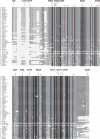The role of PHD2 mutations in the pathogenesis of erythrocytosis
- PMID: 27774468
- PMCID: PMC5045058
- DOI: 10.2147/HP.S54455
The role of PHD2 mutations in the pathogenesis of erythrocytosis
Abstract
The transcription of the erythropoietin (EPO) gene is tightly regulated by the hypoxia response pathway to maintain oxygen homeostasis. Elevations in serum EPO level may be reflected in an augmentation in the red cell mass, thereby causing erythrocytosis. Studies on erythrocytosis have provided insights into the function of the oxygen-sensing pathway and the critical proteins involved in the regulation of EPO transcription. The α subunits of the hypoxia-inducible transcription factor are hydroxylated by three prolyl hydroxylase domain (PHD) enzymes, which belong to the iron and 2-oxoglutarate-dependent oxygenase superfamily. Sequence analysis of the genes encoding the PHDs in patients with erythrocytosis has revealed heterozygous germline mutations only occurring in Egl nine homolog 1 (EGLN1, also known as PHD2), the gene that encodes PHD2. To date, 24 different EGLN1 mutations comprising missense, frameshift, and nonsense mutations have been described. The phenotypes associated with the patients carrying these mutations are fairly homogeneous and typically limited to erythrocytosis with normal to elevated EPO. However, exceptions exist; for example, there is one case with development of concurrent paraganglioma (PHD2-H374R). Analysis of the erythrocytosis-associated PHD2 missense mutations has shown heterogeneous results. Structural studies reveal that mutations can affect different domains of PHD2. Some are close to the hypoxia-inducible transcription factor α/2-oxoglutarate or the iron binding sites for PHD2. In silico studies demonstrate that the mutations do not always affect fully conserved residues. In vitro and in cellulo studies showed varying effects of the mutations, ranging from mild effects to severe loss of function. The exact mechanism of a potential tumor-suppressor role for PHD2 still needs to be elucidated. A knockin mouse model expressing the first reported PHD2-P317R mutation recapitulates the phenotype observed in humans (erythrocytosis with inappropriately normal serum EPO levels) and demonstrates that haploinsufficiency and partial deregulation of PHD2 is sufficient to cause erythrocytosis.
Keywords: EGLN1; HIF; PHD2; erythrocytosis; erythropoietin; hypoxia.
Figures



References
-
- Pearson TC, Guthrie DL, Simpson J, et al. Interpretation of measured red cell mass and plasma volume in adults: Expert Panel on Radionuclides of the International Council for Standardization in Haematology. Br J Haematol. 1995;89(4):748–756. - PubMed
-
- Johansson PL, Safai-Kutti S, Kutti J. An elevated venous haemoglobin concentration cannot be used as a surrogate marker for absolute erythrocytosis: a study of patients with polycythaemia vera and apparent polycythaemia. Br J Haematol. 2005;129(5):701–705. - PubMed
-
- Franke K, Gassmann M, Wielockx B. Erythrocytosis: the HIF pathway in control. Blood. 2013;122(7):1122–1128. - PubMed
-
- Lee FS, Percy MJ. The HIF pathway and erythrocytosis. Annu Rev Pathol. 2011:165–192. - PubMed
-
- McMullin MF. Idiopathic erythrocytosis: a disappearing entity. Hematology Am Soc Hematol Educ Program. 2009:629–635. - PubMed
Publication types
LinkOut - more resources
Full Text Sources
Other Literature Sources
Research Materials

